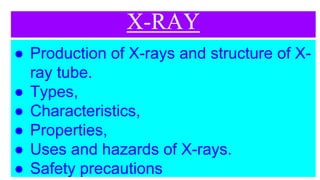X ray
- 1. X-RAY Ąņ Production of X-rays and structure of X- ray tube. Ąņ Types, Ąņ Characteristics, Ąņ Properties, Ąņ Uses and hazards of X-rays. Ąņ Safety precautions
- 3. Ąņ Production of X-rays X-rays are electromagnetic waves of short wavelength of the order of 10-10m. X-ray tube is an evacuated electron tube that produces X rays by accelerating electrons to a high velocity with a high-voltage field and causing them to collide with a target, the anode plate.
- 6. ,
- 7. ENERGY TRANSFORMATION Electrical energy Heat energy Kinetic energy Heat energy Electromagnetic radiation
- 8. Soft and Hard X-rays X-rays are usually described by their maximum energy, which is determined by the voltage between the electrodes. hard X-rays are with high photon energies (above 5ĻC10 keV) soft X-rays with lower energy (and longer wavelength).
- 9. Differences between hard X-rays and soft X-rays 1. . hard X-rays soft X-rays High penetrating power. Low penetrating power. have shorter wavelength have longer wavelength They are produced at comparatively high potential difference. They are produced at comparatively low potential difference. have high frequency and hence high energy lesser frequency and hence lesser energy
- 10. INTENSITY OF X-RAYS The intensity is the number of emitted electrons from the cathode producing the x- rays as a result of an increase in current through the filament. The intensity depends on the temperature of the filament and the temperature depends on the current in the filament.
- 11. CHARACTERISTICS OF X-RAYS I. They are electromagnetic in nature. II. They are un deflected by both the magnetic and electric field III. They have short wavelength IV. They have high penetrating power V. They have no charge VI. They are produced when a fast moving electrons strike a hard target. VII.They make materials to ionise VIII.They forge photographic plates IX. They cause fluorescence materials to glow.
- 13. USES OF X-RAYS I. They are used to detect hidden cracks in materials. II. They are used to detect alterations to works of art. III.They are used to show broken bones in human body IV.they are used in studying the structure of crystals. V. They are used in diagnosing ulcer VI.They are used in agriculture to kill germs. VII.They are used in industries to detect faults in metal casting and welding.
- 14. HAZARDS OF X-RAYS I. Genetic Mutation II. Skin burn III.Leukemia IV.Tissue damage V. Baldness VI.Graying VII.cataracts.
- 15. PRECAUTION I. Use dosimeter or badges when using X-rays. II. Wear lead coat. III.Regular and periodic medical checkup for personnels working with x-rays machine IV.Use geiger muller counter to monitor the radiation level.














